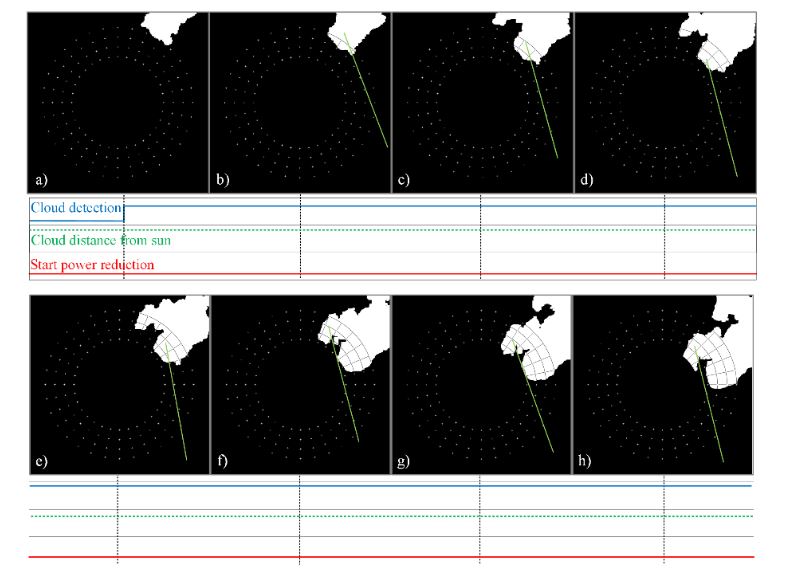ABSTRACT
Clouds moving at a high speed in front of the Sun can cause step changes in the output power of photovoltaic (PV) power plants, which can lead to voltage fluctuations and stability problems in the connected electricity networks. These effects can be reduced effectively by proper short-term cloud passing forecasting and suitable PV power plant output power control. This paper proposes a low-cost Internet of Things (IoT)-based solution for intra-minute cloud passing forecasting. The hardware consists of a Raspberry PI Model B 3 with a WiFi connection and an Omni Vision OV5647 sensor with a mounted wide-angle lens, a circular polarizing (CPL) filter and a natural density (ND) filter.
The completely new algorithm for cloud passing forecasting uses the green and blue colors in the photo to determine the position of the Sun, to recognize the clouds, and to predict their movement. The image processing is performed in several stages, considering selectively only a small part of the photo relevant to the movement of the clouds in the vicinity of the Sun in the next minute. The proposed algorithm is compact, fast and suitable for implementation on low cost processors with low computation power. The speed of the cloud parts closest to the Sun is used to predict when the clouds will cover the Sun. WiFi communication is used to transmit this data to the PV power plant control system in order to decrease the output power slowly and smoothly.
Cloud Passing Forecasting System

Figure 1. Used hardware
The camera contains a wide-angle lens. When properly oriented, it captures images of the sky with the sun and the clouds around it over the entire part of the day, where reduction of the PV power plant output power could be required. Two optical filters, a circular polarizing filter (CPL) and a natural density (ND 4) filter have been mounted in front of the wide-angle lens. The ND 4 filter reduces the density of the light that falls on the sensor and prevents its saturation and overheating. The CPL filter reduces the glare and reduces the density of the light further. The hardware part of the cloud passing forecasting system is shown in Figure 1, whilst the costs of individual hardware components are shown in Table 1.

Figure 3. Photo and its decomposition into individual RGB colors
When reflections are present, the widespread digital filter RBR (Red Blue Ratio) does not work well. In the given case, shown in Figure 3, the recognition of clouds, based on the RBR ratio is disturbed due to the reflection present mostly in the red color. The reflection is much less present in the green and the blue colors, where it is almost invisible. Therefore, the recognition of the clouds, based on the ratio between the green and the blue colors, is proposed in the form of a Green Blue Ratio (GBR) digital filter. For each pixel in the photo the values of the green (G) and the blue (B) colors are defined in the range between 0 and 255.
RESULTS

Figure 9. Moving clouds which pass by the Sun without covering it: a time sequence of processed cloud images
Figure 9 is used to demonstrate the operation of the proposed cloud passing forecasting system in the case of clouds that pass by the Sun without covering it. Figure 9a shows the cloud that covered a checkpoint which started the procedure for determining the direction of the cloud’s movement. Therefore, the next picture is taken. The image is processed and the vector is determined describing the cloud’s movement. The result is shown in Figure 9b. Since the cloud does not move towards the Sun’s center, the movement of the cloud is observed, as shown in Figure 9c–h. However, no action is taken as long as the cloud is not moving towards the Sun’s center.
CONCLUSIONS
This paper proposes a cloud passing forecasting system that can be implemented on low-cost IoT hardware and is suitable for predicting the movement of clouds in the vicinity of the Sun in a time interval of under one minute. This is achieved by the minimization of the computational effort required for image processing. The novelties proposed in this paper are the use of the green and the blue colors in the sun and cloud recognition and the procedures for:
- Detecting clouds in the vicinity of the Sun;
- Determining the cloud’s movement;
- Determining the distance between the cloud and the Sun;
- Predicting the time during which the cloud will cover the Sun.
The results presented have shown that the proposed cloud passing forecasting system can provide a reliable and sufficiently accurate prediction of cloud movement in the vicinity of the Sun. Its output signal can be used to reduce the output power of PV systems smoothly and slowly. The proposed solution is an efficient tool for the prevention of fast changes in the output power of PV systems, whilst its cost is lower than the cost of a single 270 Wp PV module.
Source: University of Maribor
Authors: Primoz Suki c | Gorazd Stumberger